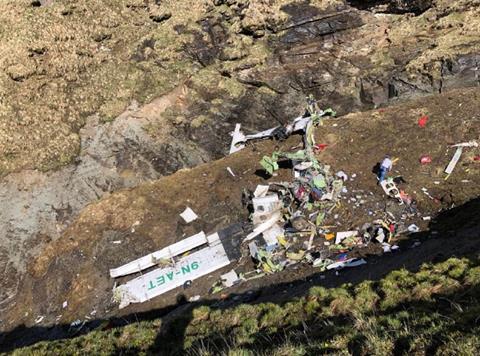The ineffective use of aircraft warning systems, poor weather, and crew dynamics contributed to the crash of a Tara Air turboprop in Nepal on 29 May 2022.
The Viking Air DHC-6-300 (9N-AET) was destroyed when it impacted mountainous terrain while operating flight TRA197 the Pokhara-Jomsom route. The crash killed 19 passengers and three crew.

According to the final report into the crash by Nepal’s Aircraft Accident Investigation Commission (AAIC), the crew may have felt pressured to operate the route, even though the 62-year-old pilot was concerned about poor weather. The AAIC also reveals that he was paired with a far younger and relatively inexperienced first officer: the captain had logged 17,500 total flight hours versus 520h for the co-pilot.
On the morning of the accident flight, Jomsom Airport opened for operations following an improvement of weather. Two other aircraft, Let L-410s operated by Summit Air, departed Pokhara for Jomsom. The Tara flight had been scheduled to go second, but AAIC observes that the pilot “seemed hesitant to commence the flight” following weather reports from the first Summit L-410.
The report states, however, that the pilot of the Tara aircraft may have felt pressured by the departure of the two Summit flights, as well as a full cabin of passengers. In its analysis of the cockpit-voice recorder (CVR), the AAIC says that a passenger or ground crewmember can be heard urging the pilot to press ahead with the flight.
During the flight, which saw deteriorating weather conditions, the captain even expressed his dissatisfaction with “the behaviour of other pilots who conduct [visual flight rules] flights in such unfavourable weather.”
“The CVR recordings reveal that the aircraft was encountering clouds and the [pilot] was trying his best to remain clear of the clouds,” says the AAIC.
“During the course of flight, TRA197 hadn’t reported any abnormalities encountered and neither any technical defect on aircraft either to Jomsom tower or Pokhara tower. As per CVR, [the pilot] was searching for light and brighter areas and adamantly heading towards it. As per CVR and V2 tracker data, the aircraft was maintaining 12,000ft and was in a climbing attitude.”
CONTRIBUTING FACTORS TO CRASH
- The flight crew’s failure to follow standard operating procedures
- Inhibited TAWS
- Loss of situational awareness
- Deteriorating weather
- Experience discrepancy between pilot and first officer
- Poor crew resource management
- Pilot assumed most cockpit duties, which “likely impaired his performance”
- Underutilization of navigation instruments
The CVR also indicated that the aircraft’s Terrain Avoidance and Warning System (TAWS) was inhibited, likely owing to the crew’s desire to avoid nuisance warnings, which were being generated because the system was incorrectly calibrated.
Three seconds before impacting Sanusare mountain, 7.7nm (14km) southwest of Jomsom airport, at an altitude of 13,300ft, the CVR indicates that that the crew received a ground proximity warning alert. Had the TAWS system been functioning properly, the AAIC contends that it would have provided the crew with earlier warnings that may have averted the disaster.
The aircraft had a flight-data recorder, but lacked the necessary sensors and data collection capabilities for flight data to be recorded.
The AAIC makes several recommendations, specifically for carriers to ensure that TAWS is set up correctly, and that nuisance reports be flagged to aid with remediation. It also directs the Civil Aviation Authority of Nepal to ensure that TAWS is functioning correctly on commercial aircraft operating in the country.


























